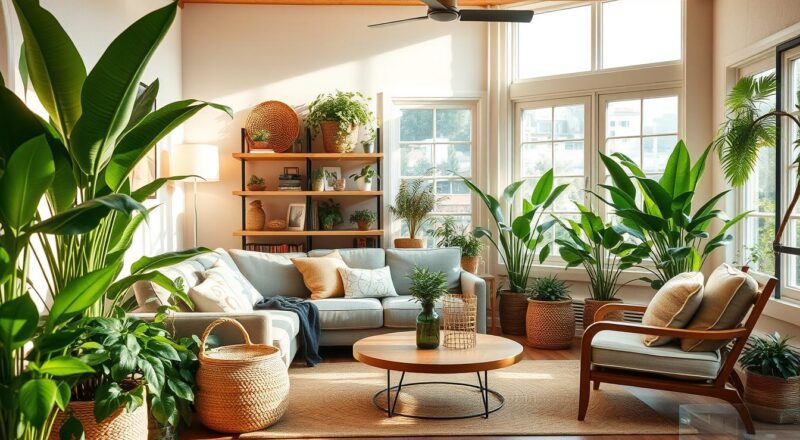Living a green life doesn’t have to be expensive. It’s all about smart choices that help our planet and save money. By adding simple, sustainable habits to our daily lives, we can enjoy a green lifestyle that’s both budget-friendly and meaningful.
Turning off lights when not in use or using renewable energy are great starts. Just think, switching to LED bulbs or insulating your home can cut down costs. By composting or choosing eco-friendly travel, we make choices that benefit our wallets and the Earth. Let’s discover many ways to live sustainably without spending a lot.
- Key Takeaways
- Understanding the Basics of Green Living
- Making Your Home Energy Efficient
- Tips for Reducing Water Usage
- Affordable Green Living Tips in Your Diet
- Reducing, Reusing, and Recycling Effectively
- Choosing Sustainable Fashion Options
- Inexpensive Ways to Live Green Through Transportation
- Eco-Friendly Cleaning and Personal Care
- Conclusion
- FAQ
- What is Sustainable Living?
- Why Affordable Green Living Matters
- What are the Three Pillars of Sustainability: Economic, Environmental, Social?
- How does switching to LED lighting benefit the environment?
- Why is improving home insulation considered a green living tip?
- What are the benefits of fixing leaks and drips in the home?
- What are the advantages of installing low-flow showerheads and faucets?
- What are the environmental benefits of a plant-based diet?
- Why is composting organic waste beneficial?
- What is the importance of proper separation in waste management?
- How do upcycling projects contribute to a sustainable home decor?
- What are the advantages of shopping second-hand for clothes?
- Why is it important to support eco-friendly brands?
- How do green transport choices like biking and public transit contribute to sustainability?
- What are the benefits of embracing carpooling and ride-sharing?
- Why should we use DIY natural cleaning solutions?
- What are the environmental benefits of choosing organic personal care products?
Key Takeaways
- Adopting an eco-friendly lifestyle is achievable without breaking the bank.
- Energy conservation plays a crucial role in affordable green living.
- Simple actions like composting can have a substantial impact on waste reduction.
- Efficient home energy use and sustainable transport options significantly cut expenses.
- Opting for a plant-based diet and eco-friendly products can further support low-cost eco-conscious living.
Understanding the Basics of Green Living
Making our way to a more sustainable life involves lots of methods to lessen our environmental impact. We do this by using sustainable living ideas and eco-friendly living hacks. It helps save natural resources and make the Earth healthier. Here, we’ll explore what it means to live sustainably, why it’s important, and the key parts that shape this earth-friendly lifestyle.
What is Sustainable Living?
Sustainable living means choosing a way of life that uses fewer of Earth’s resources. It’s about making smart choices to keep nature in balance. This includes using renewable energy, cutting down on waste, and living by frugal environmental lifestyle tips. The aim is more than just lowering our carbon footprint. It’s about making sure nature can recover and remain vibrant.
Why Affordable Green Living Matters
Affordable green living is key for both the environment and fairness among people. By using cost-effective sustainable living tips, we make sure everyone can join in, no matter their money situation. This way, we reduce the harsh effects of climate change on those who are most at risk. Making green living affordable is essential in today’s efforts to protect the environment.
The Three Pillars of Sustainability: Economic, Environmental, Social

Sustainability rests on three main pillars: economic, environmental, and social. These are also known as profits, planet, and people. They show that real sustainability needs actions that are good for the economy, safe for the planet, and fair to all people. Below, you’ll see how each pillar supports our big goal of living sustainably:
| Pillar | Focus | Goal |
|---|---|---|
| Economic | Cost-effective practices | Ensure long-term affordability and reduce financial barriers to green living. |
| Environmental | Reduce resource use and environmental impact | Maintain ecological balance and reduce carbon footprint. |
| Social | Equity and accessibility | Provide equal access to sustainable resources and reduce inequalities. |
Learning and using the ideas behind these three pillars means we choose a life that’s good for the planet, fair to people, and economically sound. As we adopt more sustainable living ideas and eco-friendly living hacks, we must always think of these crucial areas.
Making Your Home Energy Efficient
To live greener and save money, two big steps help a lot: using LED lighting and improving insulation. These upgrades are good for the planet and your wallet. They give your home an energy-efficient boost.
Switching to LED lighting is a smart, eco-friendly move. LEDs use a lot less electricity than old-school bulbs and they last way longer. This cuts down on energy and reduces waste.
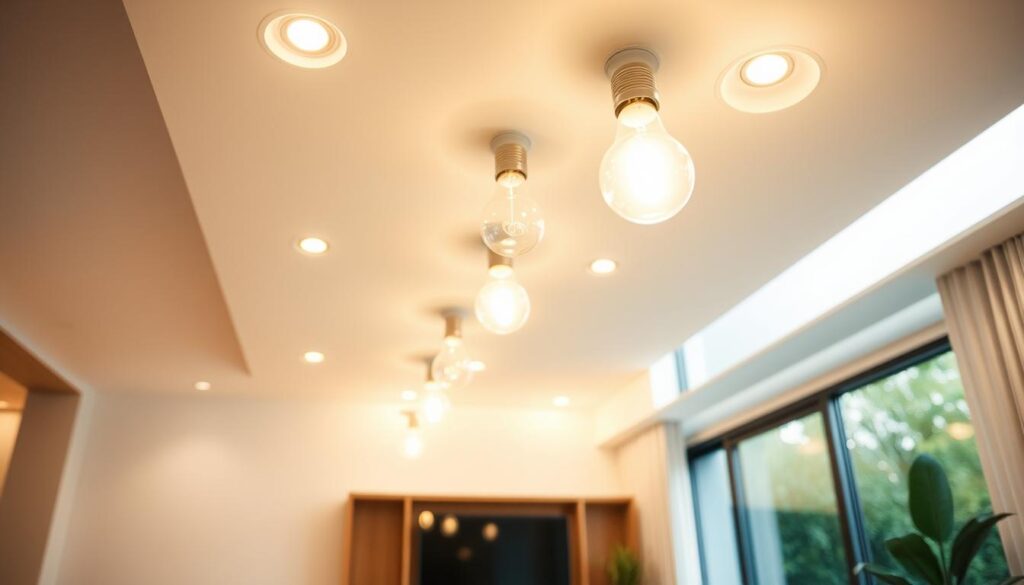
Better insulation is also smart for both the environment and your budget. It keeps your house warm in the winter and cool in the summer. This means you don’t need to use your heating or cooling system as much. You’ll save energy and cut down on costs.
It’s easy for anyone to make their home more eco-friendly. Just start with your lights and insulation. Doing this saves you money and helps our planet. These steps are simple but really effective for a greener, more affordable home.
Tips for Reducing Water Usage
Starting with inexpensive ways to go green usually means looking at how we use water every day. We have some easy green lifestyle changes to help you use less water. And you won’t have to give up convenience.
Fixing Leaks and Drips
Fixing leaks and drips is a cheap way to live more sustainably. Even a little drip can waste a lot of water over time. So, regularly check faucets, showerheads, and pipes for leaks to save water and money.
Installing Low-flow Showerheads and Faucets
Modern low-flow showerheads and faucets cut water use by half but still keep water pressure strong. This change is great for sustainable living on a budget. Plus, it helps you save money on your water bill in the long run.
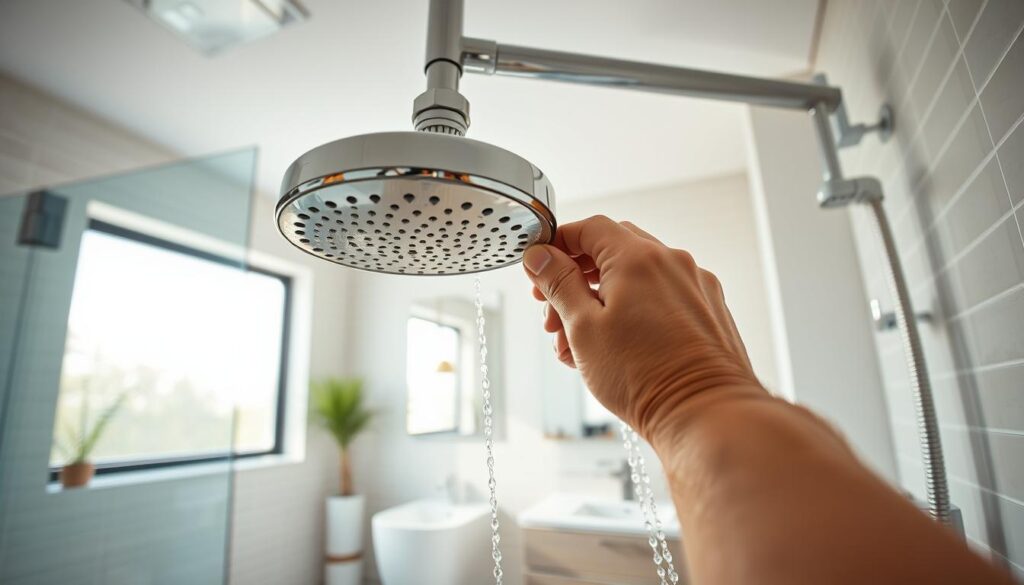
Affordable Green Living Tips in Your Diet
Starting eco-friendly habits in your kitchen is easy. We can save money and reduce our environmental impact by changing what we eat. This fits well with tips for living green affordably. Eating less meat and not wasting food are great ways to support sustainable living ideas.
Benefits of a Plant-Based Diet
Eating more plants and less meat helps decrease our environmental footprint. Choosing veggies, beans, grains, and fruit saves water and reduces greenhouse gases. Trying out a plant-based diet part-time is budget-friendly and tasty, offering variety and nutrition.
Composting Organic Waste
Composting kitchen leftovers turns trash into treasure. It cuts down landfill waste and stops methane, a harmful greenhouse gas, from forming. This natural fertilizer makes plants grow strong without harmful chemicals. It’s a smart, budget-friendly green living choice that’s good for your garden and Earth.
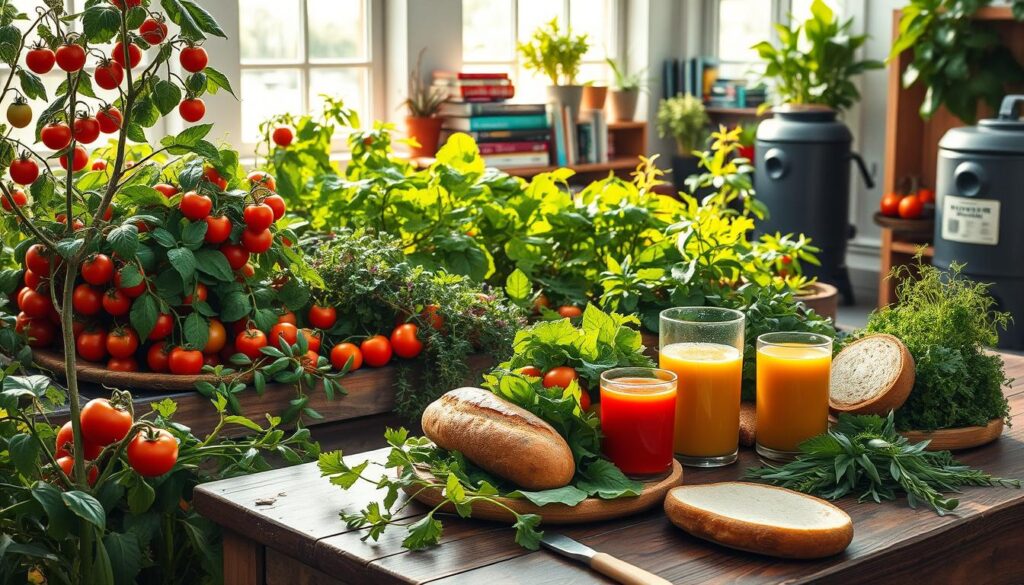
These green practices don’t just help you; they support wider affordable eco-friendly practices. Using these methods makes green living affordable and possible for everyone.
Reducing, Reusing, and Recycling Effectively
Living green on a budget means reducing, reusing, and recycling. These steps help us lessen our impact on Earth and encourage us to be clever and sustainable. We waste less and get creative in finding new ways to use old things.
It’s key to separate recyclables correctly to recycle well. We must know the differences between paper, plastic, and glass. Following local rules helps avoid contaminating recyclables, so they can be reused again.
By implementing these inexpensive ways to live green, we make a positive impact on the environment and contribute to sustainable development.
Read more: AI-Powered Code Generation: How Developers Can Leverage Automation
Read more: Remote Work Toolkit: Best Beginner Apps in 2025
Read more: Quantum computing Guide | What Is Quantum Computing?
Upcycling is a fun part of eco-friendly living. It lets us turn trash or unwanted items into better, more eco-friendly products. Here are some cool upcycling ideas:
- Turning old jars into planters or makeup organizers
- Refashioning wooden pallets into furniture such as coffee tables and bookshelves
- Using tattered clothing pieces to create quilts or colorful rags
This table suggests how to creatively reuse common items. Each project is a chance to live greener without spending much.
| Item | Upcycle Idea | Difficulty Level |
|---|---|---|
| Old T-shirts | Braided Rugs | Easy |
| Wine Bottles | Glass Lamp Bases | Moderate |
| Wood Scraps | Decorative Shelf | Advanced |
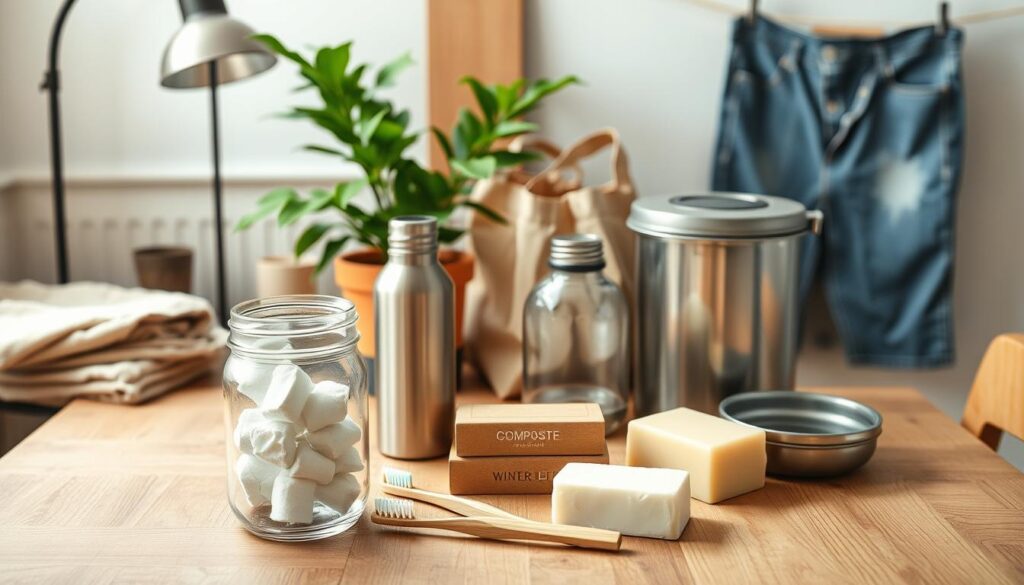
Green living tips on a budget make us better citizens. By reducing, reusing, and recycling, we follow sustainability principles. This way, we all help make our world better, one step at a time.
Choosing Sustainable Fashion Options
Sustainable fashion is more than just a trend. It’s a crucial part of living thriftily and sustainably, helping our planet stay healthy. Looking into sustainable fashion, we see great opportunities in buying second-hand and picking eco-friendly brands. These choices lead to living eco-consciously without spending a lot.
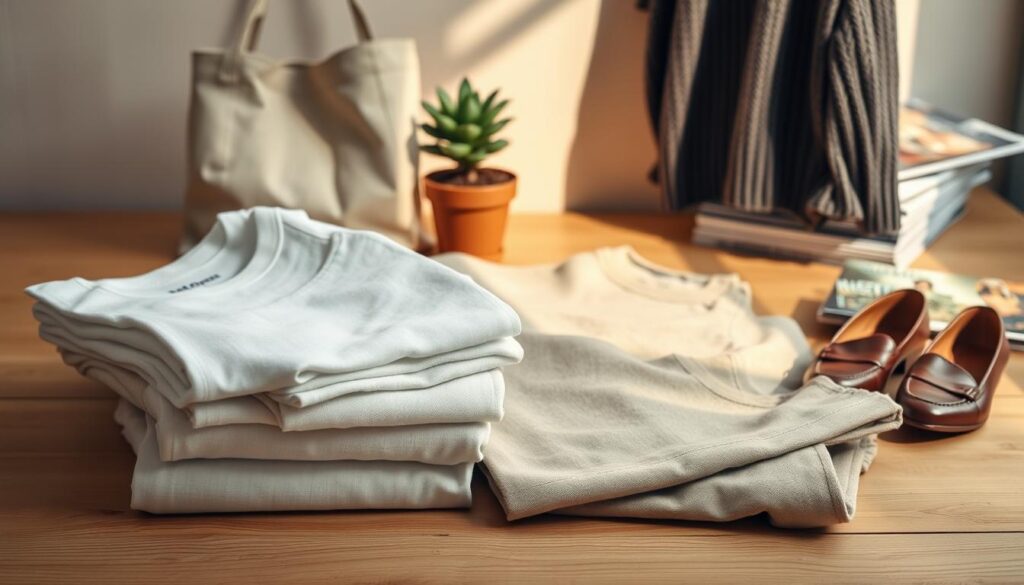
By choosing second-hand clothes, we not only save cash. We also lower the demand for fast fashion, which harms our environment. This matches eco-friendly budget tips perfectly. It lets us enjoy unique, vintage items, encourages recycling, and cuts down on waste.
Also, supporting sustainable brands means we’re choosing companies that care about our world. These brands use organic materials, aim to lower carbon footprints, and follow ethical production methods. So, they are excellent options for those wanting to live eco-consciously and affordably.
- Shopping Second-hand: Looking at local thrift shops and online stores for pre-loved items saves money and reduces waste by giving clothes another chance.
- Supporting Eco-friendly Brands: Spending money on brands that use sustainable materials and follow fair trade practices shows our support for eco-friendly living.
Inexpensive Ways to Live Green Through Transportation
Choosing greener ways to get around isn’t just good for the earth; it’s also kind to your pocket. By picking eco-friendly lifestyle ideas like biking, taking public transportation, sharing rides, and carpooling, we can lower how much pollution we create. We can also improve our connections with others. These budget-friendly green living ideas help our planet and encourage a sense of community.
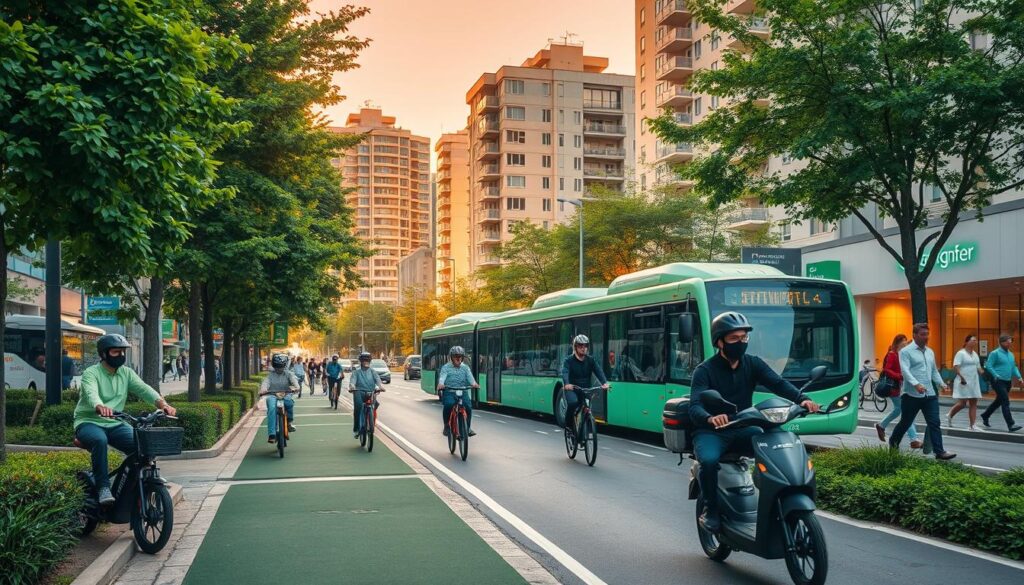
Let’s look at some big perks of these cost-effective green living ideas:
- Biking: Riding a bike reduces emissions and boosts our health. With more bike lanes and paths, it’s becoming an even better option.
- Public Transit: Catching a bus or train lowers how much pollution we each make. It also saves money on gas and car upkeep.
- Carpooling and Ride-sharing: These choices cut down travel costs and lessen the cars on the road. This means fewer emissions and less traffic.
When we use these ways of getting around, we show that green living on a budget can work well. It’s good for our wallets and for the planet. Moving towards these habits, we help make our cities more sustainable. This creates a healthier life for us and the environment.
Eco-Friendly Cleaning and Personal Care
Choosing to live eco-friendly makes our homes and planet better. It makes us use green tips that are easy on our wallets. This helps in making our world healthier and ensures a better tomorrow. Let’s dive into how to clean with care for the environment and pick organic care products.
DIY Natural Cleaning Solutions
One easy way to live greener is by making your own cleaners. Using things like vinegar, baking soda, and lemon can fight dirt well. Let me show you how to whip up your cleaners:
- All-purpose cleaner: Mix water and vinegar equally in a spray bottle for cleaning surfaces. For a nicer smell, add essential oils.
- Glass cleaner: Mix 2 tablespoons of vinegar with a quart of water. This mix makes glass sparkle without streaks.
- Scrub for tough stains: Make a paste using baking soda and water for stains. After 15 minutes, scrub it off.
Choosing Organic Personal Care Products
Using organic care products is a big eco-friendly move. They lack nasty chemicals that hurt us and our planet. Look for items with organic and sustainable badges when you shop.
Consider these eco-friendly picks:
- Organic soaps and shampoos: Made with natural stuff and oils, these clean well without harming Earth.
- Natural deodorants: With no aluminum or fake stuff, these use baking soda and coconut oil to stop bad smells.
- Biodegradable sunscreens: Choose sunscreens without oxybenzone and octinoxate to protect your skin and the ocean.
Conclusion
On our journey to live sustainably on a budget, we’ve seen how small actions can make a big difference. We’ve looked at ways to save money and be kind to our planet at the same time. This includes switching to energy-efficient lights, insulating our homes, eating more plants, and following the reduce, reuse, recycle principle.
This journey is something everyone can join. It’s for those ready to change their lifestyle for a better world. By choosing used clothes, green transport, and organic goods, anyone can help. Making thoughtful choices every day, we can build a greener future without breaking the bank.
Living green and saving money can happen now, not just in the future. By doing our part, we’re helping the environment, society, and the economy. We feel proud of the sustainable steps we can take. Together, we’re making a difference for tomorrow’s world.
Outbound Links
-
https://www.epa.gov/recycle (U.S. EPA on Recycling)
-
https://www.energystar.gov (Energy-efficient product info)
-
https://www.treehugger.com (Sustainability news & tips)
-
https://www.eartheasy.com (Sustainable living resources)
FAQ
What is Sustainable Living?
Why Affordable Green Living Matters
What are the Three Pillars of Sustainability: Economic, Environmental, Social?
How does switching to LED lighting benefit the environment?
Why is improving home insulation considered a green living tip?
What are the benefits of fixing leaks and drips in the home?
What are the advantages of installing low-flow showerheads and faucets?
What are the environmental benefits of a plant-based diet?
Why is composting organic waste beneficial?
What is the importance of proper separation in waste management?
How do upcycling projects contribute to a sustainable home decor?
What are the advantages of shopping second-hand for clothes?
Why is it important to support eco-friendly brands?
How do green transport choices like biking and public transit contribute to sustainability?
What are the benefits of embracing carpooling and ride-sharing?
Why should we use DIY natural cleaning solutions?
What are the environmental benefits of choosing organic personal care products?
Get in Touch with SJ Articles
Read more: Remote Work Toolkit: Best Beginner Apps in 2025
Read more: BioPrinting explanation very simply! 2025
Read more: Smart Devices in 2025: Shaping the Future of Home Automation


